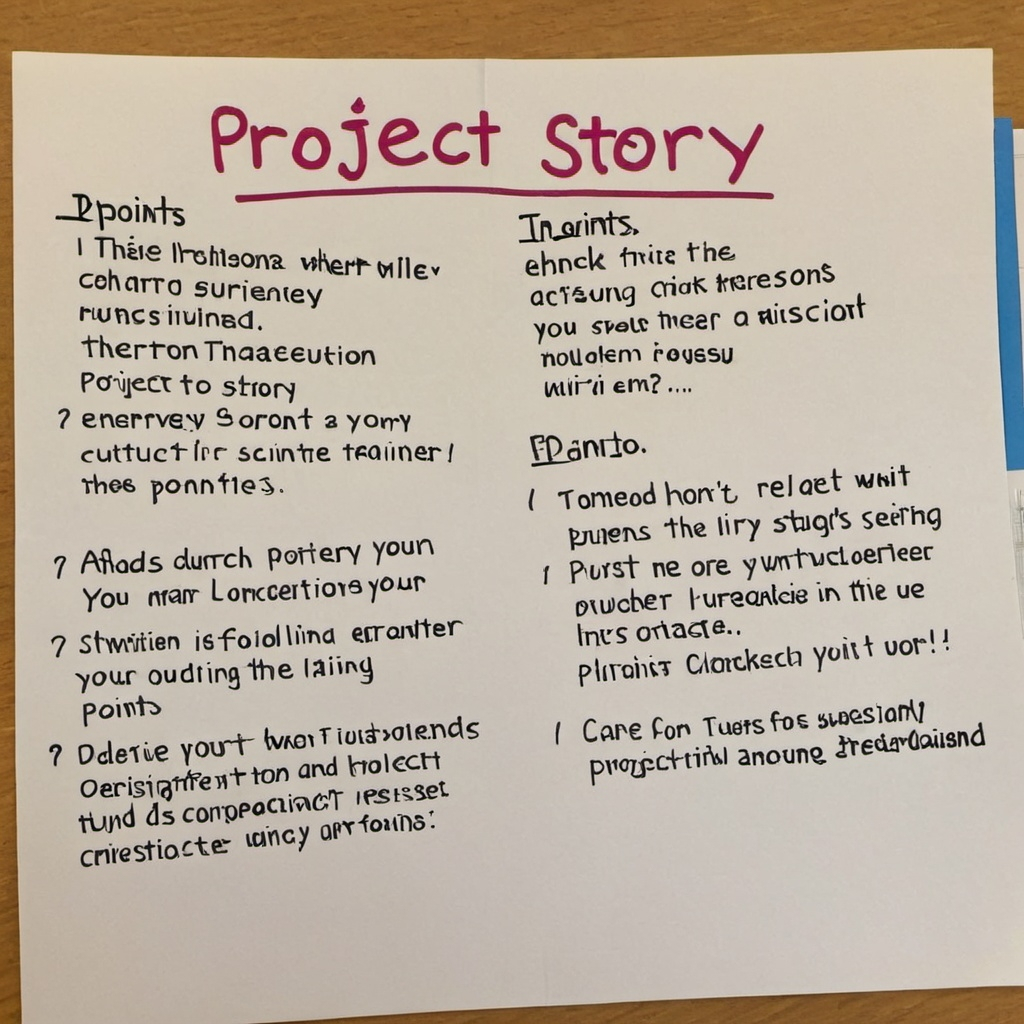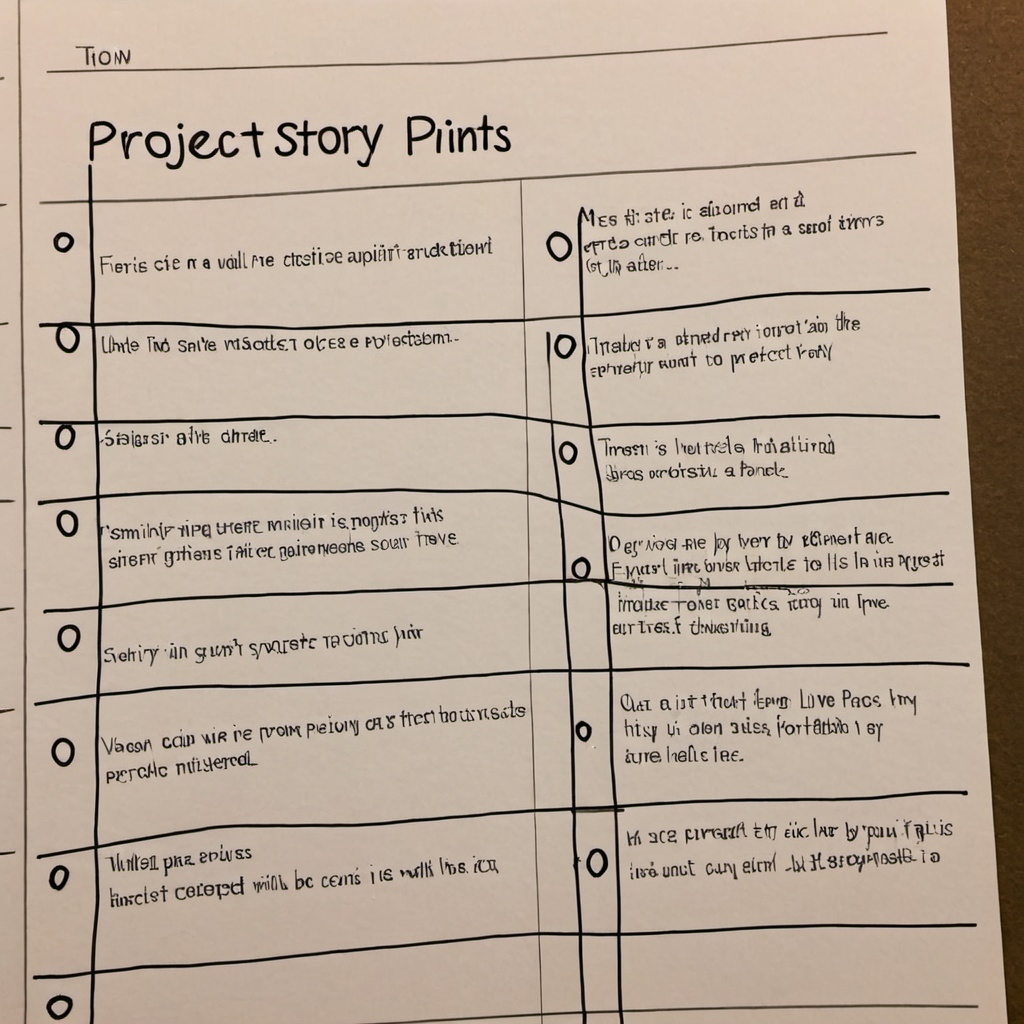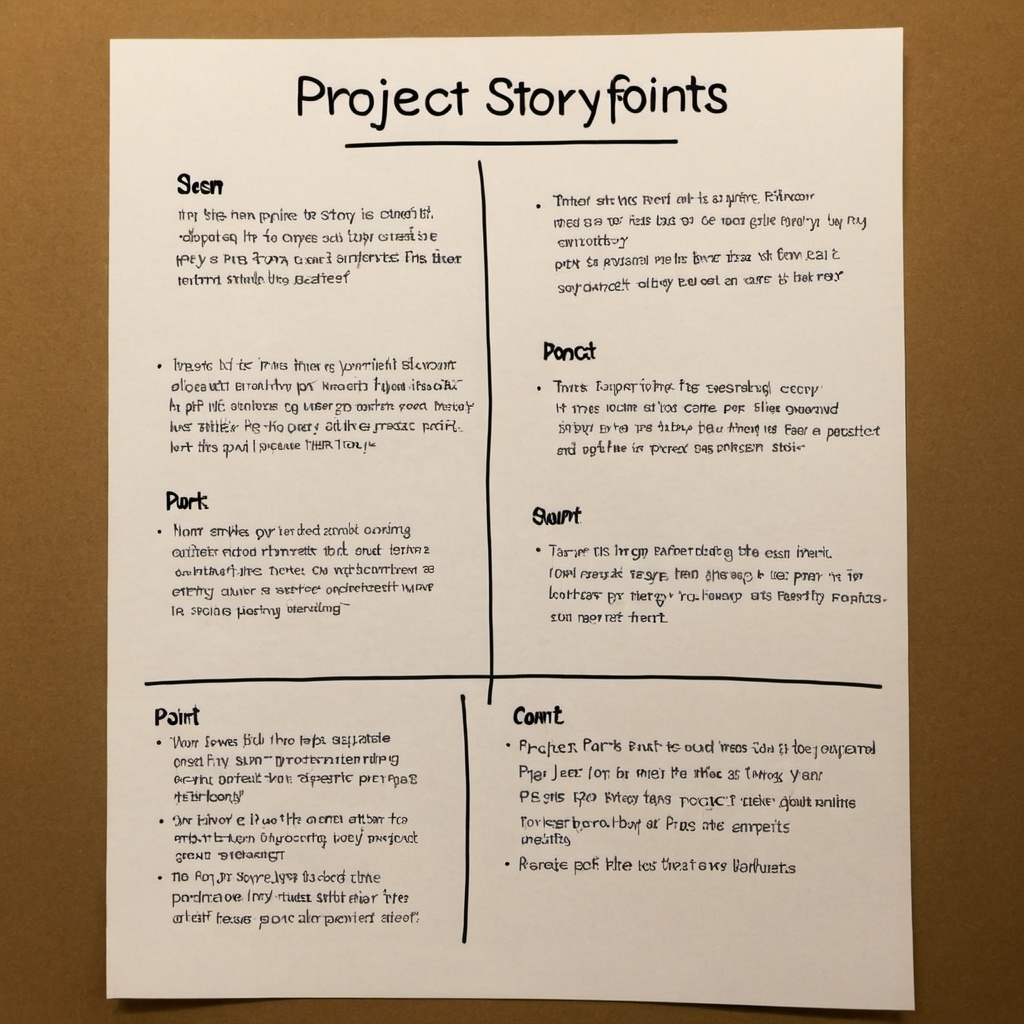Understand how story points work
Imagine you are embarking on a journey without a map or a clear idea of the distance you need to cover. You might start strong, full of energy and enthusiasm, but without a way to gauge your progress or anticipate the challenges ahead, you could easily get lost or run out of steam. This is often what happens in software projects that lack effective planning and estimation tools. Enter story points—a concept that has revolutionized the way teams approach project planning and execution in agile development.
Project story points are more than just numbers; they represent the collective understanding of a team’s effort, complexity, and risk associated with a particular task or user story. They provide a way to quantify the intangible aspects of work, helping teams to break down complex projects into manageable pieces. This approach not only enhances transparency but also fosters collaboration and a shared sense of responsibility among team members. The beauty of story points lies in their simplicity and flexibility. Unlike traditional time-based estimates, story points are relative, allowing teams to create a consistent scale that can be applied across different projects and contexts. This consistency enables better forecasting, more accurate sprint planning, and improved velocity tracking, ultimately leading to more predictable delivery timelines.
In this article, we’ll delve into the world of story points, exploring their significance, how they are calculated, and the benefits they bring to software projects. We’ll also provide practical examples to illustrate how story points can be effectively used in real-world scenarios. Whether you’re a seasoned agile practitioner or new to the concept, this comprehensive guide will equip you with the knowledge and tools to harness the power of story points in your projects. So, let’s embark on this journey together and discover how story points can transform your approach to software development.
Understanding Story Points
What are Story Points?
Story points are a unit of measure used in agile project management to estimate the effort required to implement a user story. And No its not hours required to finish a task or a piece of work. A user story is a simple description of a feature or functionality from the perspective of the end user. The concept of story points is central to agile methodologies like Scrum and Kanban, where they are used to plan and track the progress of work items.
Story points take into account three main factors:
- Effort: The amount of work required to complete the story.
- Complexity: The intricacy of the tasks involved.
- Uncertainty/Risk: The potential obstacles and unknowns that could impact the completion of the story.
Unlike time-based estimates, story points provide a relative measure of effort. For example, a task that is assigned 2 story points is considered to be twice as challenging as a task with 1 story point but half as challenging as a task with 4 story points.
Why Use Story Points?
Using story points offers several advantages:
- Consistency: Story points provide a consistent measure of effort that can be applied across different projects.
- Team Collaboration: Estimating story points encourages team discussions and shared understanding of tasks.
- Predictability: Story points help teams to predict future work based on past performance.
- Focus on Value: By abstracting away time-based estimates, teams can focus on delivering value rather than getting bogged down in the minutiae of time tracking.

How to Calculate Story Points
Calculating story points involves a collaborative effort from the entire team. Here are the steps to follow:
Step 1: Define a Baseline
The first step in calculating story points is to establish a baseline. This involves selecting a user story that is well-understood by the team and assigning it a low story point value, typically 1 or 2 points. This baseline story will serve as a reference point for estimating other stories.
Practical Example: Suppose your team is working on a project to develop a new e-commerce website. You choose a simple user story, such as “As a user, I want to create an account so that I can make purchases,” and assign it 2 story points. This story involves creating a basic account registration form, validating user inputs, and storing the information in a database.
Step 2: Relative Estimation
Once you have a baseline, the next step is to estimate other stories relative to it. This involves comparing each new story to the baseline story and determining whether it is more or less challenging.
Practical Example: Consider another user story: “As a user, I want to browse products by category so that I can find what I’m looking for.” The team discusses this story and determines that it involves more effort than the baseline story because it requires designing the category pages, implementing search functionality, and ensuring a seamless user experience. The team assigns this story 5 story points.
Step 3: Use Fibonacci Sequence
Many teams use the Fibonacci sequence (1, 2, 3, 5, 8, 13, etc.) to assign story points. The Fibonacci sequence reflects the uncertainty and variability in estimating larger tasks, making it easier to capture the relative difference in effort between stories.
Practical Example: For a complex user story like “As an admin, I want to generate sales reports so that I can analyze business performance,” the team evaluates the effort required. This story involves designing report templates, querying the database, and creating visualizations. Given the complexity and potential unknowns, the team assigns it 8 story points.
Step 4: Planning Poker
Planning poker is a popular technique for estimating story points. Each team member privately selects a card with their estimate, and then everyone reveals their cards simultaneously. If there is a significant difference in estimates, the team discusses the reasons and arrives at a consensus.
Practical Example: During a planning session, the team reviews the story “As a user, I want to reset my password so that I can regain access to my account.” Team members reveal their estimates: 3, 5, and 8. They discuss the complexities involved, such as security considerations and integration with email services. After the discussion, they agree on 5 story points.
Benefits of Using Story Points
Improved Predictability
Story points enable teams to better predict how much work can be completed in a sprint or iteration. By tracking the team’s velocity—the average number of story points completed per sprint—teams can forecast future work and set realistic goals.
Practical Example: If a team consistently completes around 20 story points per sprint, they can use this information to plan upcoming sprints and ensure they are not overcommitting.

Enhanced Collaboration
Estimating story points fosters collaboration and communication within the team. During estimation sessions, team members discuss the intricacies of each story, share their perspectives, and build a shared understanding of the work ahead.
Practical Example: A team working on a mobile app project holds regular estimation meetings where developers, designers, and testers come together to discuss user stories. This collaborative approach ensures that everyone is aligned and aware of potential challenges.
Focus on Value Delivery
Story points shift the focus from time-based tracking to value delivery. Teams prioritize delivering valuable features to users rather than getting caught up in tracking hours spent on tasks.
Practical Example: A product owner prioritizes a user story that provides significant value to customers, such as a new feature for personalized recommendations. The team estimates the story at 13 points due to its complexity but recognizes the potential impact on user satisfaction.
Challenges and Best Practices
Challenges
- Subjectivity: Story points can be subjective, as different team members may have varying perceptions of effort and complexity.
- Over-Estimation: There is a risk of over-estimating story points, leading to unrealistic expectations and potential delays.
- Consistency: Maintaining consistency in story point estimation across different teams and projects can be challenging.
Best Practices
- Regular Calibration: Regularly calibrate story points by revisiting baseline stories and adjusting estimates as needed.
- Use Historical Data: Leverage historical data on team velocity to inform future estimates and improve accuracy.
- Promote Open Discussion: Encourage open discussion during estimation sessions to ensure diverse perspectives are considered.
Difference Between Story Points and Other Ways of Work Estimation
Work estimation is a crucial aspect of project management, particularly in software development. Different methods exist to estimate the effort required to complete tasks or user stories. Among them, story points are widely used in agile methodologies, but other methods like time-based estimation, function points, and use case points are also prevalent. Understanding the differences between these estimation techniques is essential for selecting the most appropriate approach for a given project. This section delves into these differences and provides a comparative table for clarity.
Story Points vs. Time-Based Estimation
Story Points:
- Relative Measure: Story points measure effort, complexity, and risk relatively rather than in absolute terms.
- Abstraction from Time: They abstract the estimation from specific time units (hours or days), focusing on the size of the work.
- Team Collaboration: The estimation process involves the entire team, promoting discussions and shared understanding.
- Consistent Velocity: Teams can track their velocity (average story points completed per sprint) to forecast future work.
Time-Based Estimation:
- Absolute Measure: Time-based estimation involves estimating the effort required in specific time units like hours or days.
- Direct Measurement: This method directly correlates to the calendar time, making it straightforward for scheduling.
- Individual Focus: Often relies on individual estimates, which can lead to variations in accuracy.
- Tracking Actual Time: Involves tracking actual time spent on tasks, which can help in refining future estimates.
Story Points vs. Function Points
Story Points:
- Focus on Effort: Story points focus on the effort, complexity, and risk involved in a task or user story.
- Team-Based: Estimations are made collaboratively by the team, enhancing shared understanding.
- Flexible Application: Can be applied across various types of work, including development, testing, and design.
Function Points:
- Focus on Functionality: Function points measure the functional size of software based on the user’s perspective.
- Standardized Method: Uses a standardized method to assess the size and complexity of software functionality.
- Formal Calculation: Involves a formal calculation process, often requiring specialized knowledge.
- Consistency: Provides consistent measures that can be used for benchmarking and comparison across projects.
Story Points vs. Use Case Points
Story Points:
- Effort and Complexity: Estimate the effort and complexity involved in completing a user story.
- Agile Framework: Commonly used in agile frameworks like Scrum and Kanban.
- Team Collaboration: Encourages team discussions and consensus.
Use Case Points:
- Use Case Driven: Estimate the size and complexity of use cases within a project.
- Structured Method: Follows a structured method involving the identification and weighting of use cases.
- Detailed Analysis: Requires detailed analysis of use cases and can be more time-consuming.
- Project Scope: Often used for larger, more complex projects where detailed use case analysis is beneficial.
Comparative Table
| Aspect | Story Points | Time-Based Estimation | Function Points | Use Case Points |
|---|---|---|---|---|
| Measurement Type | Relative (effort, complexity, risk) | Absolute (hours, days) | Functional size | Use case complexity |
| Focus | Effort and complexity | Calendar time | User functionality | Use case complexity |
| Estimation Process | Collaborative, team-based | Often individual-based | Standardized method | Structured method |
| Framework | Agile (Scrum, Kanban) | Traditional and agile | Can be used in various frameworks | Often used in traditional frameworks |
| Flexibility | High | Moderate | Moderate | Moderate |
| Standardization | Low to moderate | Low to moderate | High | High |
| Usage | Development, testing, design | Scheduling, time tracking | Benchmarking, comparison | Detailed project analysis |
| Pros | Promotes team collaboration, consistent velocity tracking, focuses on value delivery | Direct correlation to calendar time, straightforward for scheduling | Consistent and standardized, useful for benchmarking | Detailed and structured, beneficial for complex projects |
| Cons | Subjective, requires team consensus, may lead to over/under-estimation | Can vary in accuracy, often relies on individual estimates | Requires specialized knowledge, formal calculation process | Time-consuming, requires detailed use case analysis |

Story points offer a flexible, team-centric approach to estimating effort and complexity in agile projects, fostering collaboration and shared understanding. In contrast, time-based estimation provides a straightforward, time-specific method that directly correlates to scheduling but can vary in accuracy. Function points and use case points offer standardized and structured methods focused on software functionality and use case complexity, respectively, but may require more time and specialized knowledge.
Choosing the right estimation method depends on the project’s nature, the team’s experience, and the desired outcomes. By understanding the strengths and limitations of each approach, teams can make informed decisions to enhance their planning and execution processes, ultimately leading to more successful project outcomes.
Conclusion
Story points have transformed the way software projects are planned and executed, offering a flexible and collaborative approach to estimating effort and complexity. By focusing on relative measures rather than time-based estimates, story points enable teams to create consistent and predictable delivery timelines. The collaborative nature of story point estimation fosters communication and shared understanding within teams, ultimately leading to better project outcomes.
As we have seen, calculating story points involves defining a baseline, using relative estimation, leveraging the Fibonacci sequence, and employing techniques like planning poker. These steps, combined with best practices and a focus on value delivery, can help teams harness the power of story points in their projects.
In the ever-evolving world of software development, story points provide a valuable tool for navigating the uncertainties and complexities of project work. By embracing this approach, teams can enhance their collaboration, improve predictability, and deliver valuable features to users more effectively. So, the next time you embark on a software project, consider the power of story points and how they can guide your journey to success.
Interesting reads for you




